Working from the answer of @unutbu and an intersection algorithm plucked straight from numpy-and-line-intersections I've come up with this. It is slow owing to the brute-force sort of way of finding the intersections and the loops within loops within loops. There might be a way to make the loops faster but I'm not sure about the intersection algorithm.
import matplotlib.pyplot as plt
import numpy as np
def find_intersections(A, B):
#this function stolen from https://stackoverflow.com/questions/3252194/numpy-and-line-intersections#answer-9110966
# min, max and all for arrays
amin = lambda x1, x2: np.where(x1<x2, x1, x2)
amax = lambda x1, x2: np.where(x1>x2, x1, x2)
aall = lambda abools: np.dstack(abools).all(axis=2)
slope = lambda line: (lambda d: d[:,1]/d[:,0])(np.diff(line, axis=0))
x11, x21 = np.meshgrid(A[:-1, 0], B[:-1, 0])
x12, x22 = np.meshgrid(A[1:, 0], B[1:, 0])
y11, y21 = np.meshgrid(A[:-1, 1], B[:-1, 1])
y12, y22 = np.meshgrid(A[1:, 1], B[1:, 1])
m1, m2 = np.meshgrid(slope(A), slope(B))
m1inv, m2inv = 1/m1, 1/m2
yi = (m1*(x21-x11-m2inv*y21) + y11)/(1 - m1*m2inv)
xi = (yi - y21)*m2inv + x21
xconds = (amin(x11, x12) < xi, xi <= amax(x11, x12),
amin(x21, x22) < xi, xi <= amax(x21, x22) )
yconds = (amin(y11, y12) < yi, yi <= amax(y11, y12),
amin(y21, y22) < yi, yi <= amax(y21, y22) )
return xi[aall(xconds)], yi[aall(yconds)]
x = np.linspace(-1,1,500)
X,Y = np.meshgrid(x,x)
Z1 = np.abs(np.sin(2*X**2+Y))
Z2 = np.abs(np.cos(2*Y**2+X**2))
contour1 = plt.contour(Z1,colors='k')
contour2 = plt.contour(Z2,colors='r')
xi = np.array([])
yi = np.array([])
for linecol in contour1.collections:
for path in linecol.get_paths():
for linecol2 in contour2.collections:
for path2 in linecol2.get_paths():
xinter, yinter = find_intersections(path.vertices, path2.vertices)
xi = np.append(xi, xinter)
yi = np.append(yi, yinter)
plt.scatter(xi, yi, s=20)
plt.show()

Edit: find_intersections above does not handle vertical and horizontal lines nor overlapping line segments. The linelineintersect function below does handle those cases but the whole process is still slow. I have added a count so you have some idea of how long ther is to go. I also changed contour1 = plt.contour(Z1,colors='k') to contour1 = plt.contour(X,Y,Z1,colors='k') so the axes and your intersections are in the actual X, and Y coords of your grid rather than a count of your grid points.
I think the problem is that you just have a lot of data. In one contour set there are 24 lines with a total of 12818 line segments, the other contour set has 29 lines with 11411 line segments. That's a lot of line segment combinations to check (696 calls to linelineintersect). You can get a result more quickly by using a coarser grid to calculate your functions on (100 by 100 was much faster than your original 500 by 500). You might be able to do some sort of line sweep algorithm but I don't know how to implement such things. The line intersection problem has many applications in computer games and is known as collision detection - there must be some graphics library out there that can quickly determine all the intersection points.
import numpy as np
from numpy.lib.stride_tricks import as_strided
import matplotlib.pyplot as plt
import itertools
def unique(a, atol=1e-08):
"""Find unique rows in 2d array
Parameters
----------
a : 2d ndarray, float
array to find unique rows in
atol : float, optional
tolerance to check uniqueness
Returns
-------
out : 2d ndarray, float
array of unique values
Notes
-----
Adapted to include tolerance from code at https://stackoverflow.com/questions/8560440/removing-duplicate-columns-and-rows-from-a-numpy-2d-array#answer-8564438
"""
if np.issubdtype(a.dtype, float):
order = np.lexsort(a.T)
a = a[order]
diff = np.diff(a, axis=0)
np.abs(diff,out = diff)
ui = np.ones(len(a), 'bool')
ui[1:] = (diff > atol).any(axis=1)
return a[ui]
else:
order = np.lexsort(a.T)
a = a[order]
diff = np.diff(a, axis=0)
ui = np.ones(len(a), 'bool')
ui[1:] = (diff != 0).any(axis=1)
return a[ui]
def linelineintersect(a, b, atol=1e-08):
"""Find all intersection points of two lines defined by series of x,y pairs
Intersection points are unordered
Colinear lines that overlap intersect at any end points that fall within the overlap
Parameters
----------
a, b : ndarray
2 column ndarray of x,y values defining a two dimensional line. 1st
column is x values, 2nd column is x values.
Notes
-----
An example of 3 segment line is: a = numpy.array([[0,0],[5.0,3.0],[4.0,1]])
Function faster when there are no overlapping line segments
"""
def x_y_from_line(line):
"""1st and 2nd column of array"""
return (line[:, 0],line[:, 1])
def meshgrid_as_strided(x, y, mask=None):
"""numpy.meshgrid without copying data (using as_strided)"""
if mask is None:
return (as_strided(x, strides=(0, x.strides[0]), shape=(y.size, x.size)),
as_strided(y, strides=(y.strides[0],0), shape=(y.size, x.size)))
else:
return (np.ma.array(as_strided(x, strides=(0, x.strides[0]), shape=(y.size, x.size)), mask=mask),
np.ma.array(as_strided(y, strides=(y.strides[0],0), shape=(y.size, x.size)), mask=mask))
#In the following the indices i, j represents the pairing of the ith segment of b and the jth segment of a
#e.g. if ignore[i,j]==True then the ith segment of b and the jth segment of a cannot intersect
ignore = np.zeros([b.shape[0]-1, a.shape[0]-1], dtype=bool)
x11, x21 = meshgrid_as_strided(a[:-1, 0], b[:-1, 0], mask=ignore)
x12, x22 = meshgrid_as_strided(a[1: , 0], b[1: , 0], mask=ignore)
y11, y21 = meshgrid_as_strided(a[:-1, 1], b[:-1, 1], mask=ignore)
y12, y22 = meshgrid_as_strided(a[1: , 1], b[1: , 1], mask=ignore)
#ignore segements with non-overlappiong bounding boxes
ignore[np.ma.maximum(x11, x12) < np.ma.minimum(x21, x22)] = True
ignore[np.ma.minimum(x11, x12) > np.ma.maximum(x21, x22)] = True
ignore[np.ma.maximum(y11, y12) < np.ma.minimum(y21, y22)] = True
ignore[np.ma.minimum(y11, y12) > np.ma.maximum(y21, y22)] = True
#find intersection of segments, ignoring impossible line segment pairs when new info becomes available
denom_ = np.empty(ignore.shape, dtype=float)
denom = np.ma.array(denom_, mask=ignore)
denom_[:, :] = ((y22 - y21) * (x12 - x11)) - ((x22 - x21) * (y12 - y11))
ua_ = np.empty(ignore.shape, dtype=float)
ua = np.ma.array(ua_, mask=ignore)
ua_[:, :] = (((x22 - x21) * (y11 - y21)) - ((y22 - y21) * (x11 - x21)))
ua_[:, :] /= denom
ignore[ua < 0] = True
ignore[ua > 1] = True
ub_ = np.empty(ignore.shape, dtype=float)
ub = np.ma.array(ub_, mask=ignore)
ub_[:, :] = (((x12 - x11) * (y11 - y21)) - ((y12 - y11) * (x11 - x21)))
ub_[:, :] /= denom
ignore[ub < 0] = True
ignore[ub > 1] = True
nans_ = np.zeros(ignore.shape, dtype = bool)
nans = np.ma.array(nans_, mask = ignore)
nans_[:,:] = np.isnan(ua)
if not np.ma.any(nans):
#remove duplicate cases where intersection happens on an endpoint
# ignore[np.ma.where((ua[:, :-1] == 1) & (ua[:, 1:] == 0))] = True
# ignore[np.ma.where((ub[:-1, :] == 1) & (ub[1:, :] == 0))] = True
ignore[np.ma.where((ua[:, :-1] < 1.0 + atol) & (ua[:, :-1] > 1.0 - atol) & (ua[:, 1:] < atol) & (ua[:, 1:] > -atol))] = True
ignore[np.ma.where((ub[:-1, :] < 1 + atol) & (ub[:-1, :] > 1 - atol) & (ub[1:, :] < atol) & (ub[1:, :] > -atol))] = True
xi = x11 + ua * (x12 - x11)
yi = y11 + ua * (y12 - y11)
return np.ma.compressed(xi), np.ma.compressed(yi)
else:
n_nans = np.ma.sum(nans)
n_standard = np.ma.count(x11) - n_nans
#I initially tried using a set to get unique points but had problems with floating point equality
#create n by 2 array to hold all possible intersection points, check later for uniqueness
points = np.empty([n_standard + 2 * n_nans, 2], dtype = float) #each colinear segment pair has two intersections, hence the extra n_colinear points
#add standard intersection points
xi = x11 + ua * (x12 - x11)
yi = y11 + ua * (y12 - y11)
points[:n_standard,0] = np.ma.compressed(xi[~nans])
points[:n_standard,1] = np.ma.compressed(yi[~nans])
ignore[~nans]=True
#now add the appropriate intersection points for the colinear overlapping segments
#colinear overlapping segments intersect on the two internal points of the four points describing a straight line
#ua and ub have already serverd their purpose. Reuse them here to mean:
#ua is relative position of 1st b segment point along segment a
#ub is relative position of 2nd b segment point along segment a
use_x = x12 != x11 #avoid vertical lines diviiding by zero
use_y = ~use_x
ua[use_x] = (x21[use_x]-x11[use_x]) / (x12[use_x]-x11[use_x])
ua[use_y] = (y21[use_y]-y11[use_y]) / (y12[use_y]-y11[use_y])
ub[use_x] = (x22[use_x]-x11[use_x]) / (x12[use_x]-x11[use_x])
ub[use_y] = (y22[use_y]-y11[use_y]) / (y12[use_y]-y11[use_y])
np.ma.clip(ua, a_min=0,a_max = 1, out = ua)
np.ma.clip(ub, a_min=0,a_max = 1, out = ub)
xi = x11 + ua * (x12 - x11)
yi = y11 + ua * (y12 - y11)
points[n_standard:n_standard + n_nans,0] = np.ma.compressed(xi)
points[n_standard:n_standard + n_nans,1] = np.ma.compressed(yi)
xi = x11 + ub * (x12 - x11)
yi = y11 + ub * (y12 - y11)
points[n_standard+n_nans:,0] = np.ma.compressed(xi)
points[n_standard+n_nans:,1] = np.ma.compressed(yi)
points_unique = unique(points)
return points_unique[:,0], points_unique[:,1]
x = np.linspace(-1,1,500)
X,Y = np.meshgrid(x,x)
Z1 = np.abs(np.sin(2*X**2+Y))
Z2 = np.abs(np.cos(2*Y**2+X**2))
contour1 = plt.contour(X,Y,Z1,colors='k')
contour2 = plt.contour(X,Y,Z2,colors='r')
xi = np.array([])
yi = np.array([])
i=0
ncombos = (sum([len(x.get_paths()) for x in contour1.collections]) *
sum([len(x.get_paths()) for x in contour2.collections]))
for linecol1, linecol2 in itertools.product(contour1.collections, contour2.collections):
for path1, path2 in itertools.product(linecol1.get_paths(),linecol2.get_paths()):
i += 1
print('line combo %5d of %5d' % (i, ncombos))
xinter, yinter = linelineintersect(path1.vertices, path2.vertices)
xi = np.append(xi, xinter)
yi = np.append(yi, yinter)
plt.scatter(xi, yi, s=20)
plt.show()
This plot is for 50x50 grid with the actual X and Y axes:




